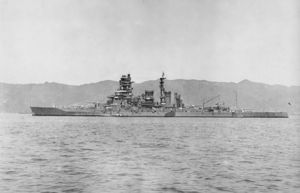 Kirishima at Tsukumo Bay on 10 May 1937.
| |
| History | |
|---|---|
| Name | Kirishima |
| Namesake | Mount Kirishima |
| Ordered | 1911 |
| Builder |
|
| Laid down | 17 March 1912 |
| Launched | 1 December 1913 |
| Commissioned | 19 April 1915 |
| Fate | Sunk following the Naval Battle of Guadalcanal on 15 November 1942 |
| General characteristics | |
| Class and type | Kongō-class battlecruiser |
| Displacement | 36,600 long tons (37,187 t)[1] |
| Length | 222 m (728 ft 4 in)[1] |
| Beam | 31 m (101 ft 8 in)[1] |
| Draught | 9.7 m (31 ft 10 in)[1] |
| Propulsion | Steam turbines, 4 shafts |
| Speed | 30 knots (35 mph; 56 km/h)[1] |
| Range | 10,000 nmi (19,000 km) at 14 kn (26 km/h)[1] |
| Complement | 1360 |
| Armament |
|
| Armor |
|
Kirishima (Japanese: 霧島, named after Mount Kirishima) was a warship of the Imperial Japanese Navy which saw service during World War I and World War II. Designed by British naval engineer George Thurston, she was the third launched of the four Kongō-class battlecruisers. Laid down in 1912 at the Mitsubishi Shipyards in Nagasaki, Kirishima was formally commissioned in 1915 on the same day as her sister ship, Haruna. Kirishima patrolled on occasion off the Chinese coast during World War I, and helped with rescue efforts following the 1923 Great Kantō earthquake.
Starting in 1927, Kirishima's first reconstruction rebuilt her as a battleship, strengthening her armor and improving her speed. From 1934, a second reconstruction completely rebuilt her superstructure, upgraded her engine plant, and equipped her with launch catapults for floatplanes. Now fast enough to accompany Japan's growing carrier fleet, she was reclassified as a fast battleship. During the Second Sino-Japanese War, Kirishima acted primarily as a support vessel and troop transport, moving army troops to mainland China. On the eve of World War II, she sailed as part of Vice-Admiral Chuichi Nagumo's Kido Butai as an escort for the six carriers that attacked Pearl Harbor on 7 December 1941.
As part of the Third Battleship Division, Kirishima participated in many of the Imperial Japanese Navy's early actions in 1942, providing support for the invasion of the Dutch East Indies (now Indonesia) and in the Indian Ocean raid of April 1942. During the Battle of Midway, she provided escort to Nagumo's four carriers, before redeploying to the Solomon Islands during the Battle of Guadalcanal. She escorted Japanese carrier fleets during the battles of the Eastern Solomons and Santa Cruz Islands, before sailing as part of a bombardment force under Admiral Nobutake Kondō during the Naval Battle of Guadalcanal.
On the evening of 13 November 1942, Kirishima engaged American cruisers and destroyers alongside her sister ship Hiei. On the night of 14/15 November, in one of only two battleship duels of the Pacific War, Kirishima attacked and damaged the American battleship USS South Dakota before being fatally crippled in turn by the battleship USS Washington under the command of then Captain Glenn B. Davis. Kirishima capsized and sank in the early morning on 15 November 1942 in Ironbottom Sound.